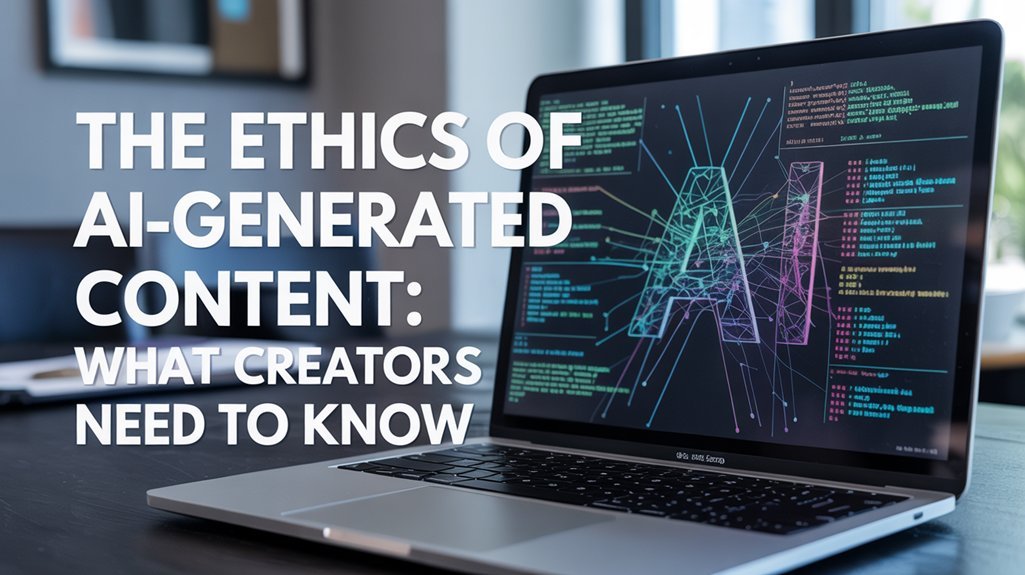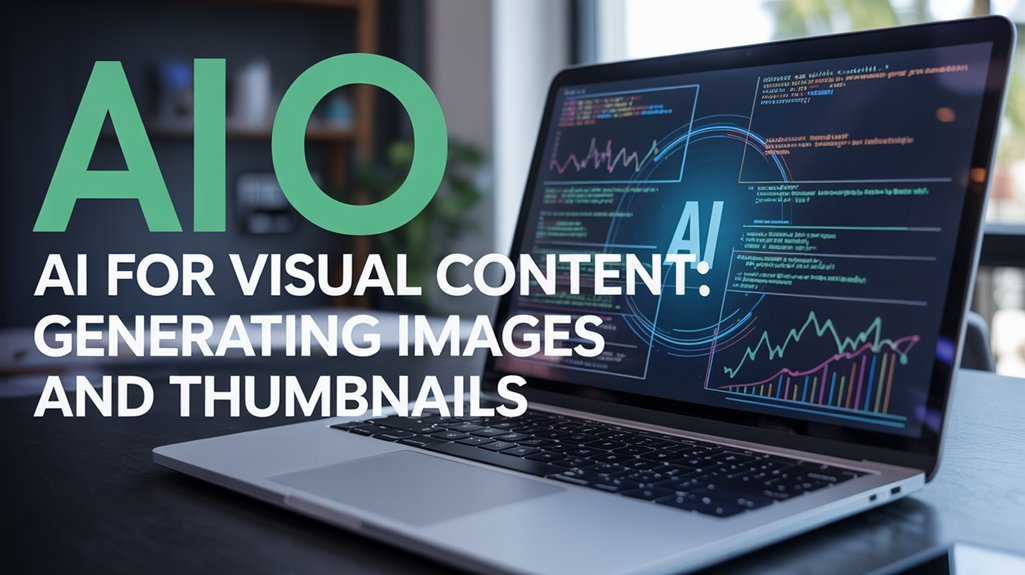You'll need to balance AI's efficiency with critical ethical safeguards as this technology reshapes content creation. Transparency matters most—97% of business owners recognize it impacts credibility, so you should clearly label AI-generated material and maintain human oversight through systematic review protocols. You're also responsible for addressing algorithmic bias, securing proper consent for data usage, and verifying licensing compliance to avoid legal exposure. These aren't optional considerations but strategic imperatives that'll determine whether you build lasting trust or risk reputational damage in an increasingly scrutinized landscape.
Key Takeaways
- Transparency builds trust: 97% of business owners confirm clear AI disclosure and labeling strengthens brand credibility and consumer loyalty.
- Privacy compliance is critical: obtain explicit consent before using personal data to avoid GDPR violations and maintain audience trust.
- AI inherits biases from training data, requiring regular audits and diverse inputs to prevent discrimination and protect brand reputation.
- Verify licensing and document creative processes to avoid copyright infringement claims when deploying AI-generated content.
- Human oversight through systematic review protocols ensures content accuracy, eliminates misinformation risks, and maintains quality standards.
Understanding AI-Generated Content and Its Rapid Growth
Although AI-generated content emerged from decades of computational research, its mainstream adoption has accelerated dramatically in just the past few years.
You're witnessing a technological shift poised to reach $1.3 trillion by 2032, fundamentally reshaping how content gets created and distributed. Platforms like ChatGPT and DALL-E2 demonstrate the sophisticated capabilities of large language models and generative algorithms, enabling you to produce diverse content assets—from articles to artwork—with unprecedented efficiency.
These rapid advancements democratize content creation, eliminating traditional barriers of expertise and resources that once limited market entry. You can now generate high-quality material quickly, giving you competitive advantages in speed and scale.
However, this power demands responsibility. Ethical concerns surrounding misinformation, copyright infringement, and algorithmic bias aren't merely academic considerations—they're strategic risks that could undermine your credibility and operations.
Understanding these shifts positions you to utilize AI-generated content effectively while maneuvering its complexities with informed judgment. As businesses increasingly integrate these technologies, navigating the future requires balancing innovation with ethical responsibility and strategic foresight.
Transparency and Disclosure: Building Trust With Your Audience
You'll need to clearly communicate when AI has played a role in your content creation, as 97% of business owners now recognize that transparency directly impacts brand credibility.
Labels and disclaimers aren't just ethical safeguards—they're practical tools that help your audience understand your creative process and maintain trust in your brand.
When you openly share how AI contributes to your work, you're positioning yourself ahead of the curve while building stronger connections with audiences who increasingly value authenticity.
Consider implementing AI-powered email management to efficiently handle disclosure inquiries and maintain consistent communication with your audience about your AI usage practices.
Labeling AI-Generated Content
When your audience encounters AI-generated content without disclosure, you're making a choice that directly impacts their trust in your brand.
Labeling AI-generated content isn't optional—it's strategic risk management. Clear disclaimers prevent misunderstandings that could trigger backlash, while transparency actually drives engagement. Research confirms audiences respond more favorably when you're upfront about AI involvement.
Your competitive advantage lies in authentic disclosure practices. Even unintentional misrepresentation erodes brand credibility irreversibly.
Consider implementing behind-the-scenes content that showcases your AI workflow—this positions you as an industry leader rather than someone hiding technological adoption.
The power relationship shifts when you control the narrative. Proactive labeling demonstrates confidence in your creative process while meeting audience expectations for information authenticity.
As AI in everyday life continues to unlock new possibilities for content creation, establishing transparent practices now positions you ahead of inevitable industry regulations.
You're not just protecting your reputation; you're establishing authority through transparency.
Communicating Your AI Use
Your disclosure strategy requires more sophistication than simple labels—it demands an extensive communication framework that positions AI as a collaborative tool rather than a replacement for human creativity.
Strategic transparency about AI integration strengthens your competitive position: 82% of consumers prefer brands demonstrating ethical use through clear disclosure practices.
Utilize behind-the-scenes content showcasing your creative process, emphasizing human input alongside AI contributions. This narrative framing resonates powerfully—73% of audiences prefer content that feels personal and relatable.
Transparency converts directly to loyalty: 70% of consumers actively support brands that openly communicate their technology use.
Position yourself advantageously by treating AI disclosure not as risk mitigation, but as a trust-building mechanism that differentiates your brand while preempting reputation damage that affects 65% of non-transparent competitors.
Consider integrating a CRM and AI solutions approach to systematically track and communicate your AI usage across all customer touchpoints, ensuring consistent transparency throughout your marketing operations.
Privacy, Consent, and Data Protection in AI Content

As AI systems increasingly draw upon vast datasets to generate content, they've created a complex web of privacy concerns that organizations can no longer afford to ignore.
You're traversing a landscape where privacy, consent, and data protection aren't merely compliance checkboxes—they're strategic imperatives. Using individuals' likenesses or personal information without explicit authorization exposes you to GDPR violations and reputational damage.
The power you wield through AI content generation demands rigorous data governance. Implement consent mechanisms directly into your AI workflows. Verify that your training datasets contain only ethically sourced material with proper rights clearance.
Your competitive advantage lies in transparent data practices that demonstrate you've secured necessary permissions before deployment. The brands that'll dominate this space understand that protecting identity builds the trust required for sustained influence.
Your audience expects you to know how their data flows through your systems—and they're watching how you respond when those boundaries are tested.
Addressing Bias and Discrimination in AI Models
Every AI model inherits the biases present in its training data—a reality that changes content generation from a technical challenge into an ethical minefield. Societal biases manifest in hiring algorithms, content recommendations, and creative outputs, undermining your strategic objectives and exposing your organization to reputational damage.
| Bias Type | Business Impact | Required Action |
|---|---|---|
| Gender discrimination | Lost talent, legal liability | Diverse datasets, regular audits |
| Racial stereotyping | Market alienation, brand erosion | Expert review panels |
| Socioeconomic assumptions | Reduced audience reach | Continuous algorithm adjustment |
Research confirms AI systems perpetuate existing inequalities without intervention. You must implement systematic audits and engage subject matter experts from marginalized communities. This isn't merely compliance—it's competitive advantage. Organizations addressing these ethical issues proactively gain market trust while competitors face backlash. Your power lies in converting AI from a liability into an instrument of equitable influence through deliberate, evidence-based mitigation strategies.
Intellectual Property and Plagiarism Concerns

When AI systems generate content by synthesizing patterns from millions of copyrighted works, they create a legal paradox that challenges centuries of intellectual property doctrine.
You're traversing uncharted territory where ownership disputes between developers and creators remain unresolved, and unintentional plagiarism threatens your credibility when outputs mirror copyrighted material.
To protect your position and mitigate risk, implement these controls:
- Verify licensing compliance before deploying AI tools in your workflow.
- Document your creative process to establish clear authorship trails.
- Audit AI outputs against existing works to prevent infringement claims.
The absence of regulatory frameworks leaves ethical questions unanswered, but strategic creators are establishing effective methodologies now.
While regulations lag behind technology, forward-thinking creators are building robust frameworks to navigate the emerging AI content landscape.
Secure proper consent when training models on protected material. Your competitive advantage depends on understanding these ambiguities—those who master intellectual property considerations will dominate while others face litigation.
The power lies in proactive governance, not reactive compliance.
Human Oversight and the “Human-in-the-Loop” Approach
Strategic delegation between artificial and human intelligence determines whether AI-generated content builds or erodes organizational credibility.
You'll optimize competitive advantage through the human-in-the-loop approach, which positions your team as final arbiters of content quality before publication. This framework requires systematic review protocols where specialists evaluate AI outputs against accuracy standards, brand alignment, and ethical considerations.
Your implementation strategy demands three core elements: regular content audits that expose algorithmic biases stemming from training data limitations, thorough employee education on AI tool deployment, and explicit guidelines governing oversight responsibilities.
This infrastructure doesn't just mitigate misinformation risks—it establishes operational transparency that differentiates market leaders from followers.
The evidence supports your investment in human oversight. Organizations maintaining rigorous review processes report improved stakeholder trust and superior content credibility.
You're not constraining AI's potential; you're strategically boosting it through informed human judgment that protects your brand's authority while capturing AI's efficiency gains.
Best Practices for Ethical AI Content Creation

Although artificial intelligence accelerates content production, your organization's ethical foundation rests on deliberate implementation frameworks that balance efficiency with responsibility.
Establishing dominance in AI content creation requires strategic approaches that fortify credibility while maintaining competitive advantage:
Strategic AI implementation fortifies market position through credible frameworks that deliver measurable competitive advantages while establishing industry dominance.
- Implement rigorous verification protocols – Deploy systematic fact-checking mechanisms before publication to eliminate misinformation risks and protect institutional authority.
- Leverage diverse data inputs – Curate training datasets that minimize algorithmic biases, guaranteeing your content reaches broader audiences without alienating key demographics.
- Mandate transparency disclosures – Clearly indicate AI involvement in content generation, converting potential vulnerabilities into trust-building opportunities that distinguish your brand from competitors.
Your ethical AI content creation strategy must evolve continuously.
Regular policy audits guarantee alignment with emerging regulations and shifting stakeholder expectations. This proactive stance positions your organization as an industry leader while mitigating legal exposure.
Frequently Asked Questions
What Are the 5 Key Principles of AI Ethics?
You'll need to master five core principles:
Transparency standards require disclosing AI involvement in your content;
Accountability measures guarantee you share responsibility for outputs with developers and regulators;
Diversity and inclusion demand varied training data to eliminate bias;
Intellectual property protocols protect creators' rights and require proper consent;
and continuous evaluation enables you to audit content regularly.
These principles aren't merely guidelines—they're strategic imperatives that'll position you as an ethical authority while maintaining competitive advantage in AI-driven markets.
What Are the Ethical Concerns in Ai-Generated Content?
Like a master forger's paintings flooding galleries, AI-generated content raises critical concerns you must navigate.
You'll face challenges with authorship rights—who owns machine-created work?
Content authenticity becomes murky when algorithms fabricate convincing falsehoods.
Bias mitigation demands your attention, as AI perpetuates dataset prejudices.
You're also contending with privacy violations when systems exploit personal data without consent.
While these issues are substantial, you can implement ethical frameworks that position you advantageously in this evolving landscape.
What Are the 7 Principles of Ethical AI?
You'll find the seven principles of ethical AI center on fairness, accountability, transparency, privacy, security, inclusiveness, and sustainability.
These frameworks demand algorithmic transparency in your decision-making processes and enforce user accountability across stakeholders.
Through responsible innovation, you're positioned to utilize AI's revolutionary potential while mitigating systemic risks.
Evidence suggests that organizations implementing these principles maintain competitive advantages, though success requires sustained commitment to evolving standards and measurable outcomes that demonstrate genuine ethical integration.
What Are 5 Ethical Considerations in AI Use?
How can you wield AI responsibly while maintaining competitive advantage?
You'll need to address five critical considerations:
Bias Mitigation through diverse training data,
Copyright Issues by securing proper licenses,
Transparency Standards when disclosing AI use,
privacy protection for personal data,
and misinformation prevention through fact-checking.
Research shows these safeguards aren't just ethical imperatives—they're strategic assets.
You'll build stakeholder trust while positioning yourself ahead of inevitable regulations, reshaping ethical compliance into market differentiation.
Conclusion
You're standing at the crossroads of a change that'll reshape content creation forever. While AI tools offer unprecedented efficiency, they demand your thoughtful stewardship. You'll need to balance innovation with responsibility—maintaining transparency, respecting privacy, and ensuring human oversight. The evidence suggests that creators who embrace ethical frameworks now won't just avoid pitfalls; they'll build more authentic, trustworthy relationships with their audiences. Your commitment to these principles will define content creation's future.










